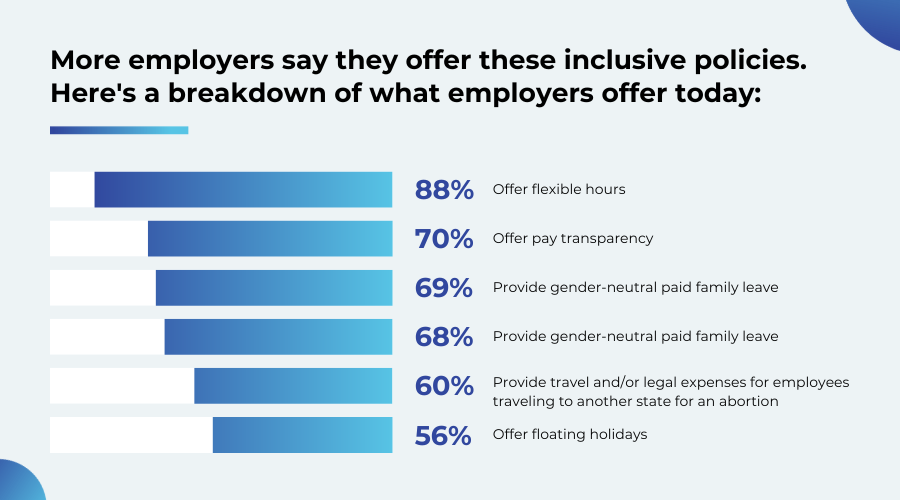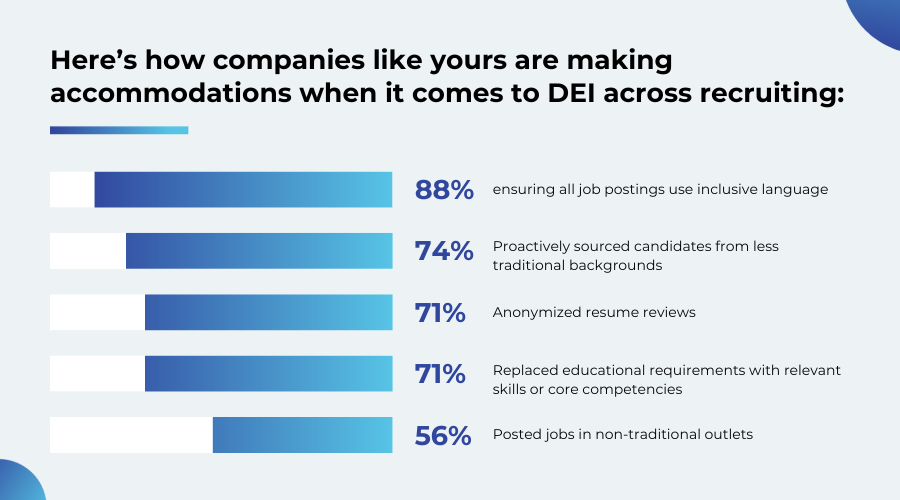Organizations large and small that prioritize diversity, equity, and inclusion (DEI) continue to see the benefits in their business. Companies and workers benefit greatly from prioritizing a diverse culture of inclusion and support.
Businesses that have a wide diversity of representation in employee ability, gender identity, ethnicity, neurodiversity, familial status, and personal beliefs are more likely to succeed in their industries compared to others that don’t.
It’s become a key metric for success that it’s now an evaluation category for the Fortune 500 list, reminding companies just how important it is to consistently improve their organizational DEI — and proving that the best lead by example.
Diversity begins with recruiting: 8 things to consider with your enterprise’s DEI recruiting strategy
A diverse company begins with recruiting and focusing on its importance cannot be overstated.
Within talent acquisition, 80% of recruiting professionals said diversity hiring was a top priority last year. However, companies still struggle to build a diverse pipeline of talent to meet the standards job candidates expect.
In the coming years, companies will likely find that overlooking the opportunity to find diverse candidates or minimizing DEI will make them less attractive to potential employees.
But, the critical point to remember is that modern DEI makes considerations for much more than ever before. Here are the eight ways to look at DEI across recruiting:
1) Racial diversity
The phrase DEI usually evokes thoughts of racial diversity, a vital component of inclusion plans in any organization. Race refers to a person’s grouping based on physical traits despite races not being biologically defined. Examples of racial identifications include Caucasian, African, and Asian.
2) Cultural diversity
Cultural diversity can mean something different to everyone, but in this case, we’re using it to refer to culture in regard to ethnicity. There are a great many ethnic groups acknowledged worldwide, but examples include Black or African American, American Indian, Hispanic, Native Hawaiian, or Other Pacific Islander.
3) Gender diversity
Traditionally, gender has been depicted as either male or female. As the spectrum of gender is more inclusive, gender diversity can include cisgender, gender fluid, or agender individuals.
Companies considering gender inclusion in their company will avoid gender-specific language in job descriptions and other content to avoid accidental discrimination or alienation of any particular identification.
4) Generational diversity
Generational diversity is the concept of employing a wide range of generations within a company. Today there are likely four different generations in your talent pipeline: Gen Z, Millennials, Gen X, and Baby Boomers.
5) Sexual orientation
Diversity in sexual orientation means making space for individuals using classifications gathered under the acronym LGBTQIA+. This stands for Lesbian, Gay, Bisexual, Transgender, Queer, Intersex, and Asexual, with the ‘plus’ indicating this list continues for many more characterizations.
6) Familial status
Familial status refers to inclusion in the workplace regardless of a person’s role outside of the home. Supporting DEI regardless of familial status includes those with or without children and allows for multiple definitions of family.
7) Physical and mental disabilities
The disability community is diverse, but very often overlooked. Disability diversity may come in physical form, from wheelchair accommodations to audio aid for visually impaired people. But, disability inclusion also includes neurodivergence, which refers to cognitive functioning which is outside of what is considered ‘typical’.
This can include conditions such as Autism, ADHD, Down Syndrome, Dyslexia, and many more.
8) Work experience diversity
Diversity of experience encompasses the breadth and depth of work experience across many roles, functions, types of organizations, industries, and more. Similarly, educational diversity demonstrates an understanding that not every role requires a certain level of education.
Inclusion in this area means understanding the many different backgrounds and experiences that can make a person well-suited for a role, rather than a single line of promotions.
The state of DEI in the workplace
When it comes to securing a job, employees often feel their race, gender or ethnicity had a major impact on their employment. Half of employees believe their race, gender, or ethnicity has hindered them in securing a job.
Many employees have made an active effort to hide parts of their identity (e.g., removing profile pictures from LinkedIn; hiding their accent, physical disability, or natural hair) to increase their chances of getting hired.
Unfortunately, many employees believe DEI is just a checkbox for their org, which is why many job seekers are now more diligent in discussing such matters.
Not only are candidates looking at what you say about DEI, but they’re also not shy about holding companies accountable. About 80% of job candidates have checked a company’s website for their stance on DEI before applying. And 57% of employees ask their employer about the culture of DEI at the company in the interview.
This data reveals that companies must clearly communicate their commitment to diversity, equity, and inclusion, but also execute these programs well to attract (and keep) top talent.

Where companies are hitting the mark with DEI recruiting and hiring efforts today
Drastic improvements have been made over the last year, ranging from DEI-centered hiring to increased training for onboarding experiences. Compared to last year, companies have improved communications around DEI efforts, shared their DEI stats publicly, and required DEI training as a part of their onboarding experience.

Looking forward with promise
Many thought leaders in the industry believe that progress within DEI efforts starts with a diverse pipeline.
While this is a major contributor to having a more diverse talent pool, the key to success is a strong culture of inclusivity and belonging. The improvement in these areas is a promising sign, as we look toward the future.
For deeper insight into DEI across recruiting, download the comprehensive report: Diversity, Equity, and Inclusion Spotlight: Examining DEI Across the Talent Lifecycle.




